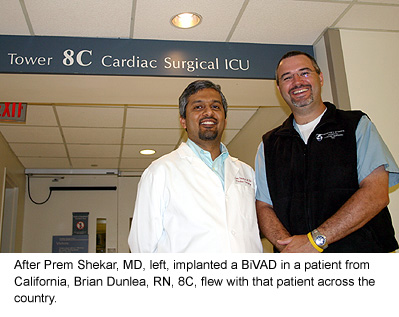Going the Extra Miles

BWHnurses go to great lengths to care for their patients.
Brian Dunlea, RN, a critical care nurse in the Cardiac Surgery Intensive Care Unit, can measure his lengths in miles-nearly 7,000. In April, Dunlea flew across the country to monitor a patient on a BiVAD while airborne.
The BiVAD, a double-pump ventricular assist device known as the “bridge” to heart transplantation, worked to perfection. The patient, a 53-year-old engineer from San Jose, successfully received a heart transplant at Stanford University Hospital last month.
“I was simply one of many BWHers involved and fortunate enough to be asked,” said Dunlea, a nurse at BWH for nearly eight years. “I'm proud of what we do here with these devices, and, by all means, we function outside the walls when called upon.”
The patient had ventricular tachycardia (an irregular heartbeat), and came to BWH for an ablation in the Electrophysiology Laboratory. The ablation procedure did not rectify his condition, so implanting a BiVAD was the next step.
Cardiac surgeon Prem Shekar, MD implanted the BiVAD and the patient recovered for a few weeks in an ICU before being transferred to a step-down unit. The patient then wanted to return home to California to await a heart transplant.
Sarah Thompson, RN, nurse manager on 8CD, asked Dunlea to fly across the country on a Leer jet Air Ambulance because the paramedic and nurse assigned to the flight were unfamiliar with the BiVAD. “They hadn't worked with them, so I went along,” Dunlea said.
“The trip went well. It was uneventful and the patient now has a sense of relief. Finally, he's home,” said Dunlea.
The patient is doing well at home after his heart transplant. Dunlea credited the successful team effort to Shekar; Lynne Stevenson, MD, co-director of the Cardiomyopathy and Heart Failure Program; Colleen Smith, a nurse practitioner in the cardiac assist device program; and Thompson.